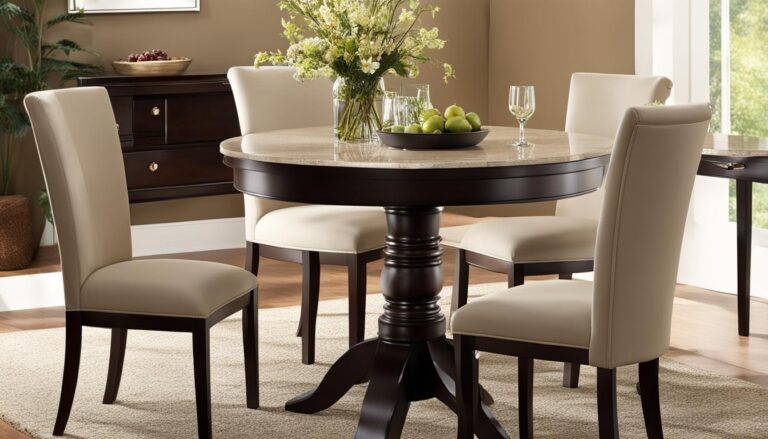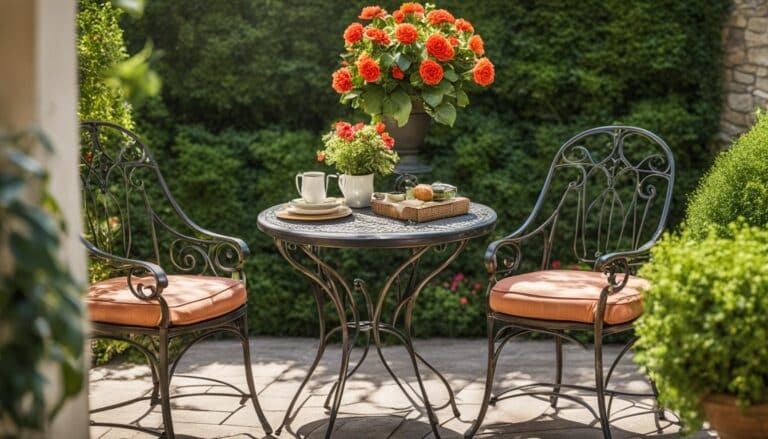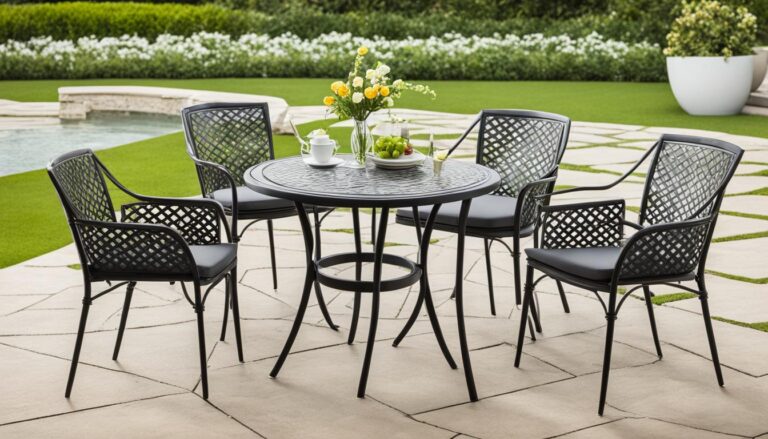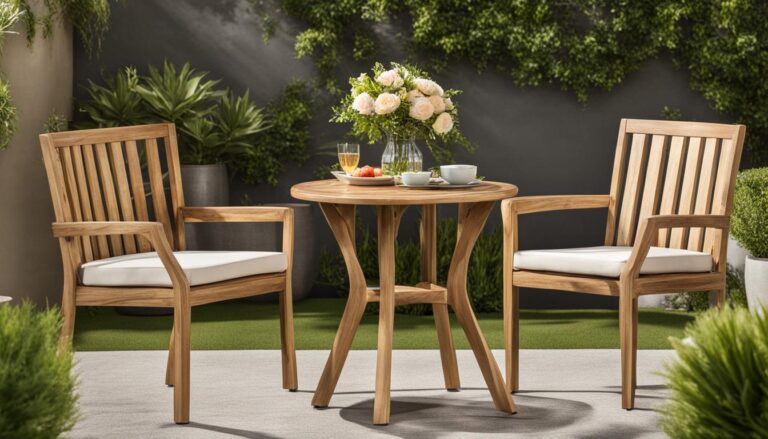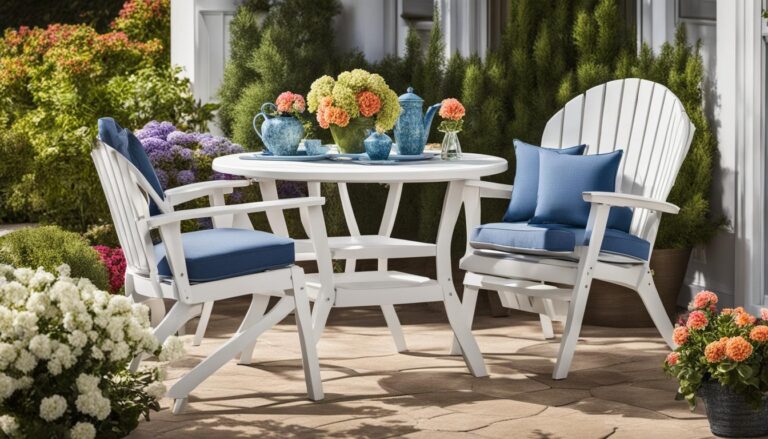Are you looking to preserve the beauty and longevity of your outdoor wicker furniture? With the right protection tips, you can ensure that your furniture withstands the elements and remains in excellent condition for years to come.
In this article, we will provide you with expert advice on how to protect your outdoor wicker furniture. From anchoring and covering to sealing and cleaning, these tips will help you maintain the functionality and beauty of your outdoor oasis.
Key Takeaways:
- Secure your outdoor furniture during high winds by tying down chairs and closing umbrellas.
- Use custom covers that provide protection from UV rays and allow air circulation.
- Protect cushion fabric by using a sun and water repellent solution and bringing cushions indoors during the off-season.
- Seal wooden outdoor furniture with polyurethane to enhance its natural beauty and protect it from sun damage.
- Apply paste wax to metal and aluminum furniture to provide a protective barrier from the elements.
Anchoring and Covering Outdoor Furniture
When it comes to protecting your outdoor furniture, anchoring and covering are two essential strategies. These methods will help safeguard your furniture from unpredictable weather conditions, harsh UV rays, and strong winds, ensuring its longevity and preserving its beauty.
Anchoring Your Outdoor Furniture
- Stack and tie down chairs: Stacking and tying down your chairs can prevent them from being blown away during storms or gusty winds. Consider using bungee cords or rope to secure the chairs tightly together.
- Close and store umbrellas: If you have umbrellas on your outdoor furniture, make sure to close them and store them securely when not in use. This will prevent them from being damaged or blown away by the wind.
- Tie cushions to the furniture: To prevent cushions from flying off during windy conditions, use ties or straps to secure them to the furniture frames. This will keep them in place and protect them from getting dirty or damaged.
Covering Your Outdoor Furniture
Using covers is another effective way to protect your outdoor furniture from the elements. Here are some key considerations when choosing covers for your furniture:
- Right size: Ensure that the covers you choose are the right size for your furniture. Ill-fitting covers may not provide adequate protection.
- Air circulation: Opt for covers that allow for proper air circulation. This will prevent moisture buildup and mold formation.
- UV protection: Look for covers that offer protection from UV rays. UV rays can cause fading and damage to your furniture over time.
By anchoring your outdoor furniture and using quality covers, you can take proactive steps to safeguard your investment and enjoy your outdoor living space for years to come.
Shielding Cushion Fabric and Sealing Wood
To protect the fabric of your outdoor cushions, there are a few simple steps you can take. First, spray your cushions with a sun and water repellent solution. This will create a protective barrier that prevents fading and yellowing caused by the sun’s UV rays. It will also make your cushions more resistant to water damage, keeping them looking fresh and vibrant for longer.
During the off-season or when you’re not using your outdoor furniture, it’s a good idea to bring the cushions indoors. This will protect them from harsh weather conditions and prolong their lifespan. Store them in a dry and clean area where they won’t be exposed to moisture or extreme temperatures.
When it comes to wooden outdoor furniture, applying a sealant is crucial to its protection. Consider using a polyurethane sealant, as it provides a strong barrier against the sun’s rays and enhances the natural beauty of the wood. Make sure to apply the sealant following the manufacturer’s instructions and reapply it annually or as needed.
Additional Tips:
- Clean the cushions regularly by removing any dirt or debris. You can use a soft brush or vacuum cleaner to gently remove surface dirt.
- If you notice any stains on the cushion fabric, treat them as soon as possible with a mild soap and water solution.
- For deep cleaning, consider using a mild oil-based soap or a homemade cleaner specifically formulated for outdoor fabrics.
- Avoid using harsh chemicals or bleach, as they can damage the fabric fibers.
- Inspect your wooden furniture regularly for any signs of wear or damage. Address any issues promptly to prevent further damage.
By taking these steps to shield your cushion fabric and seal your wooden furniture, you’ll ensure their longevity and keep them looking great for years to come.
Adding Shade and Wax to Metal Furniture
Protecting your outdoor furniture from sun damage is essential to ensure its longevity. By adding shade and applying wax to metal and aluminum furniture, you can create a protective barrier against the elements.
Shade for Sun Protection
Placing your outdoor furniture under an umbrella or shaded structure can shield it from the harmful effects of the sun. Direct exposure to sunlight can cause fading, cracking, and deterioration of metal furniture over time. By providing shade, you can minimize these risks and extend the lifespan of your furniture.
Applying Wax for Extra Protection
Another effective method to protect metal and aluminum furniture is to apply a coat of paste wax. The wax acts as a barrier, preventing moisture, dirt, and chemicals from penetrating the surface. It also helps to minimize oxidation and corrosion, which can lead to rust formation. By regularly applying wax to your outdoor furniture, you can maintain its appearance and protect it from the damaging effects of the weather.
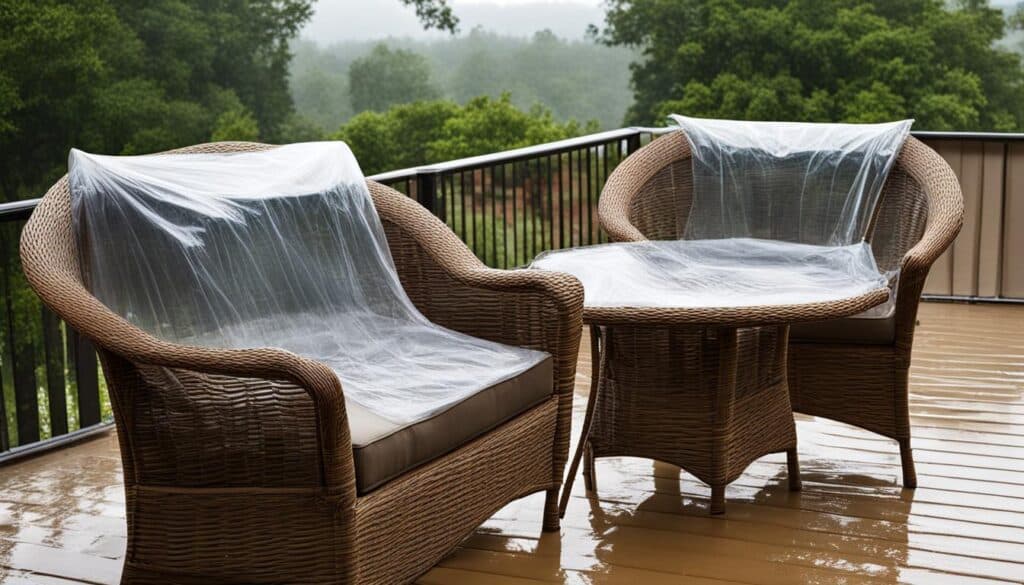
Summary:
- Apply an outdoor furniture protectant spray to prevent fading and cracking of plastic furniture.
- Store plastic furniture indoors during the off-season to prevent water damage.
- Clean and dry the furniture before storing it to prevent mold or mildew growth.
Cleaning and Maintaining Wicker Furniture
When it comes to keeping your outdoor wicker furniture looking its best, regular cleaning and maintenance are key. By following a few simple steps, you can ensure that your wicker furniture remains in great condition for years to come.
Start by dusting or vacuuming off any surface dirt or debris. This will help prevent dirt from becoming embedded in the wicker weave. For a deeper clean, create a solution of mild oil-based soap and warm water. Use a soft brush or sponge to gently scrub the wicker, being careful not to apply too much pressure that could damage the fibers. Rinse thoroughly with clean water and allow the furniture to air dry.
If your wicker furniture has stains or stubborn grime, you can try using a homemade cleaner. Mix equal parts vinegar and water, then add a few drops of dish soap. Apply the solution to the stained area and scrub gently with a soft brush. Rinse well and allow the furniture to dry completely. Avoid using harsh chemicals or abrasive cleaners, as these can damage the wicker material.
As you clean your wicker furniture, take the opportunity to inspect it for any signs of damage or wear. Look for loose or broken strands, unraveling weave, or any other issues. If you notice any problems, it’s best to seek professional repair to prevent further damage. Regular maintenance and prompt repairs will help ensure the longevity of your outdoor wicker furniture, allowing you to enjoy it for years to come.
Choosing Waterproof Furniture and Restoring Wicker
When it comes to outdoor furniture, choosing waterproof materials can make a big difference in durability and longevity. Consider options such as polyethylene, resin, or oil-based hardwood that are designed to withstand the elements while retaining their beauty. These materials are resistant to water damage, rot, and warping, making them perfect for outdoor use. By investing in waterproof furniture, you can ensure that your outdoor space remains stylish and functional for years to come.
For those who have antique wicker furniture or want to restore the natural beauty of their wicker pieces, there are specific techniques to follow. To restore natural wicker, apply linseed oil to the furniture to bring out its warm glow and rejuvenate its appearance. For painted wicker, choose high-quality outdoor paint in a color that complements your outdoor space, and finish with a marine varnish for added protection. It’s important to note that if you have antique wicker furniture, leaving it in its original state can preserve its value and charm, so avoid painting unless necessary.
Benefits of Waterproof Furniture:
- Resistant to water damage, rot, and warping
- Durable and long-lasting
- Retains its beauty even in harsh weather conditions
- Provides a stylish and functional outdoor space
Restoring Wicker Furniture:
- Apply linseed oil to restore natural wicker
- Choose high-quality outdoor paint for painted wicker
- Finish with a marine varnish for added protection
- Preserve the value and charm of antique wicker pieces
By choosing waterproof furniture and implementing proper restoration techniques for wicker pieces, you can enjoy outdoor furniture that withstands the elements and adds beauty to your outdoor space. Whether you’re looking to relax on a rainy day or entertain guests in the sun, investing in durable and well-maintained outdoor furniture will enhance your outdoor living experience.
Conclusion
Preserving wicker furniture is crucial to ensure its longevity and maintain its beauty. By following these expert tips, you can effectively care for your outdoor wicker furniture and enjoy it for years to come.
Start by anchoring and covering your furniture to protect it from high winds. Stack and tie down chairs, close and store umbrellas, and secure cushions to prevent them from blowing away. Utilize tarps or custom covers to shield the furniture from the elements when it’s not in use. Remember to choose covers that allow air circulation and provide UV protection.
Shielding cushion fabric and sealing wooden furniture are essential steps in proper care. Spray cushions with a sun and water repellent solution to prevent fading and yellowing. During the off-season, bring the cushions indoors to protect them from harsh weather conditions. Seal wooden furniture with polyurethane to safeguard it from the sun’s rays and enhance its natural beauty.
Additionally, consider adding shade to your outdoor space to protect your furniture from sun, wind, and rain damage. Place your furniture under an umbrella or shaded structure whenever possible. For metal and aluminum furniture, apply a coat of paste wax to create a protective barrier. If you notice any rust or corrosion, remove it, apply primer and paint, and then coat with wax.
Protecting plastic furniture and storing your outdoor pieces correctly during the off-season is equally important. Apply an outdoor furniture protectant spray to prevent fading and cracking of plastic material. Avoid storing outdoor furniture outside during the winter to mitigate water damage. Before storing, clean your furniture thoroughly to prevent the growth of mold or mildew. Use a dish soap and water solution or a pressure washer for sturdy furniture.
Regular cleaning and maintenance are vital for keeping wicker furniture in top condition. Dust or vacuum off surface dirt regularly, and wash with a soft brush and soapy water to remove grime. For a more thorough cleaning, use mild oil-based soap or a homemade cleaner. Remember to inspect your furniture for any damage and seek professional repair if necessary.
When choosing outdoor furniture, consider purchasing pieces made from waterproof materials like polys, resins, or oil-based hardwood. For natural wicker, restore its warm glow by applying linseed oil. If you have painted wicker furniture, use appropriate paint and marine varnish to restore its appearance. Ultimately, embrace the character of antique wicker pieces and avoid painting them to preserve their value.
Remember, by caring for your outdoor wicker furniture using these expert tips, you can extend its lifespan and maximize your enjoyment for years to come.
FAQ
How can I protect my outdoor furniture from high winds?
To protect your outdoor furniture from high winds, stack and tie down chairs, close and store umbrellas, tie cushions to the furniture, and use tarps or custom covers to shield the furniture when not in use.
How can I prevent fading and yellowing of outdoor furniture cushions?
To prevent fading and yellowing of outdoor furniture cushions, spray them with a sun and water repellent solution. When leaving outdoor furniture frames out year-round, bring the cushions indoors during the off-season.
How can I protect wooden outdoor furniture from the sun’s rays?
To protect wooden outdoor furniture from the sun’s rays, seal it with polyurethane. This will not only protect it from the sun but also enhance its natural beauty.
How can I protect outdoor furniture from sun, wind, and rain damage?
To protect outdoor furniture from sun, wind, and rain damage, place it under an umbrella or shaded structure. Additionally, apply a coat of paste wax to metal and aluminum furniture to provide a protective barrier from the elements.
How can I prevent fading and cracking of plastic outdoor furniture?
To prevent fading and cracking of plastic outdoor furniture, apply an outdoor furniture protectant spray. Avoid storing outdoor furniture outside during winter to prevent water damage.
How do I clean outdoor wicker furniture?
To clean outdoor wicker furniture, dust or vacuum off surface dirt, wash with a soft brush and soapy water to remove grime. For more thorough cleaning, use mild oil-based soap or a homemade cleaner. Avoid using harsh chemicals.
What materials should I look for in waterproof outdoor furniture?
Consider purchasing outdoor furniture made from waterproof materials such as polys, resins, or oil-based hardwood. These materials will help protect your furniture from water damage.
How can I restore natural wicker furniture?
To restore natural wicker furniture, apply linseed oil for a warm glow. For painted wicker, use appropriate paint and marine varnish. Avoid painting antique wicker pieces to preserve their value.


